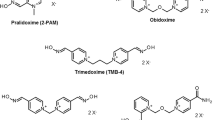Opinion statement
Organophosphate (OP) insecticide toxicity is the leading cause of major morbidity and death in the insecticides class. The clinical syndrome of OP toxicity varies widely, ranging from the classic cholinergic syndrome to flaccid paralysis and intractable seizures. The mainstays of therapy for OP-poisoned patients are atropine, pralidoxime, and benzodiazepines. Tachycardia is not a contraindication to treatment with atropine in OP toxicity. Atropine should be administered to alleviate respiratory distress, symptomatic bradycardia, and as an adjunct to benzodiazepines to alleviate seizure activity. Atropine should not be administered systemically to alleviate miosis. In acute OP toxicity, a continuous pralidoxime infusion should be considered. Intermediate syndrome and OP-induced delayed neuropathy may occur in select patients with OP poisoning.
Similar content being viewed by others
References and Recommended Reading
Litovitz TL, Klein-Schwartz W, White S, et al.: 2000 Annual Report of the American Association of Poison Control Centers Toxic Exposure Surveillance System. Am J Emerg Med 2001, 19:337–395.
O’Malley M: Clinical evaluation of pesticide exposure and poisonings. Lancet 1997, 349:1161–1166.
Kwong TC: Organophosphate pesticides: biochemistry and clinical toxicology. Ther Drug Monit 2002, 24:144–149.
Clark RF: Insecticides: organic phosphorous compounds and carbamates. In Goldrank’s Toxicologic Emergencies, edn 7. Edited by Goldfrank LR, Flomenbaum NE, Lewin, NA, et al. New York: McGraw-Hill; 2002:1346–1360.
Carlton FB, Simpson WM, Haddad LM: The organophosphates and other insecticides. In Clinical Management of Poisoning and Drug Overdose, edn 3. Edited by Haddad LM, Shannon MW, Winchester JF. Philadelphia: WB Saunders Company; 1998:836–845.
Senanayake N, Karalliedde L: Neurotoxic effects of organophosphate insecticides: an intermediate syndrome. N Engl J Med 1987, 316:761–763.
He F, Xu H, Qin F, et al.: Intermediate myasthenia syndrome following acute organophosphate poisoning: an analysis of 21 cases. Hum Exp Toxicol 1998, 17:40–45. This paper presents a case review of 21 patients who developed intermediate syndrome and the clinical scenario and treatment they received.
DeBleecker J, Van den Neucker K, Colardyn F: Intermediate syndrome in organophosphorous poisoning: a prospective study. Crit Care Med 1993, 21:1706–1711.
Glynn P: Neuropathy target esterase. Biochem J 1999, 344:625–631. This manuscript is a thorough review of neuropathy target esterase and its known role in OP-induced neuronal injury.
Saadeh AM: Metabolic complications of organophosphate and carbamate poisoning. Trop Doct 2001, 31:149–152. This paper describes the metabolic complications seen in 84 adult patients after acute OP poisoning, and the treatment initiated in those patients to correct those metabolic complications.
Medicis JJ, Stork CM, Howland MA, et al.: Pharmacokinetics following a loading plus a continuous infusion of pralidoxime compared with the traditional short infusion regimen in human volunteers. J Toxicol Clin Toxicol 1996, 34:289–295. This study indicates that a loading dose followed by a continuous infusion of pralidoxime maintains therapeutic concentrations for a longer period of time than the historically recommended intermittent bolus infusion method.
Schexnayder S, James LP, Kearns GL, et al.: The pharmacokinetics of continuous infusion pralidoxime in children with organophosphate poisoning. J Toxicol Clin Toxicol 1998, 36:549–555. This study recommends a loading dose of 25 to 50 mg/kg of pralidoxime followed by a continuous infusion of 10 to 20 mg/kg per hour in children.
Lifshitz M, Shahak E, Sofer S: Carbamate and organophosphate poisoning in young children. Pediatr Emerg Care 1999, 15:102–103. A study suggesting that the clinical manifestations of childhood OP insecticide poisoning differ from those seen in adults. Children tend to have more central nervous system effects than the classic cholinergic syndrome seen in adults.
Verhulst L, Waggie Z, Hatherill M, et al.: Presentation and outcome of severe anticholinesterase insecticide poisoning. Arch Dis Child 2002, 86:352–355. This is a retrospective review of the presentations of children who have been severely poisoned by AChE insecticides. The presence of a cardiac arrhythmia or respiratory failure is associated with a poor prognosis.
Author information
Authors and Affiliations
Rights and permissions
About this article
Cite this article
Holstege, C.P., Baer, A.B. Insecticides. Curr Treat Options Neurol 6, 17–23 (2004). https://doi.org/10.1007/s11940-004-0035-2
Issue Date:
DOI: https://doi.org/10.1007/s11940-004-0035-2




